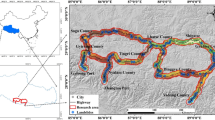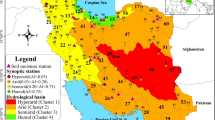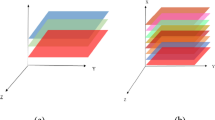Abstract
Hyperspectral images are being used in various fields. The main objective of the present study was to use hyperspectral imagery from Hyperion with Spectral Angle Mapper (SAM) and Support Vector Machine (SVM) for discriminating the landuse/landcover classes in Kozhikode district, Kerala which constitutes a combination of different physiographic land features. Hyperion functions from a space platform with modest surface signal levels and a full column of atmosphere persuading the signal, hence, the data derived from this demand careful pre-processing to minimize sensor and atmospheric noise. The atmospheric correction using MODTRAN based FLAASH module as well as the data dimensionality reduction by Principal Component Analysis (PCA) made the Hyperion to allow discrete reflectance values. Advanced classifiers like SAM and SVM could describe the pattern and spatial distribution of landcover. From the accuracy assessments, SVM showed better classified result than SAM with overall accuracy 85.6% and kappa coefficient 0.89. This study suggests that SVM can be used for landuse/landcover classification of hyperspectral data with high accuracy.





Similar content being viewed by others
References
Alcantara C, Kuemmerle T, Prishchepov AV, Radeloff VC (2012) Mapping abandoned agriculture with multi-temporal MODIS satellite data. Remote Sensing Environment. 124:334–347
Beck R (2003). EO-1 user guide, version 2.3, University of Cincinnati, satellite systems branch, USGS earth resources observation systems data Centre (EDC)
Bradley AV, Isabel MDR, Pontius Jr. RG, Ahmed ES, Araújo MB, Brown D, Brandão Jr. A, Câmara G, Tiago GSC, Hartley AJ, Smith MJ and Ewers R (2016) SimiVal, a multi-criteria map comparison tool for land use change model projections. Environmental Modelling and Softwares. 82, 229–240
Camps-Valls G, Tuia D, Bruzzone L, Benediktsson JA (2014) Advances in hyperspectral image classification. IEEE Signal Process Mag 31:45–54
Corinna C, Vladimir V (1995) Support-vector networks. Mach Learn 20:273–297
Dalponte M, Bruzzone L, Gianelle D (2012) Tree species classification in the southern Alps based on the fusion of very high geometrical resolution multispectral/hyperspectral images and LiDAR data. Remote Sens Environ 123:258–270. https://doi.org/10.1016/j.rse.2012.03.013
Fassnacht FE, Latifi H, Stereńczak K, Modzelewska A, Lefsky M, Waser LT, Straub C, Ghosh A (2016) Review of studies on tree species classification from remotely sensed data. Remote Sens Environ. https://doi.org/10.1016/j.rse.2016.08.013
George PP, Arvanitis K and Sigrimi N (2012). Hyperion hyper spectral imagery analysis combined with machine learning classifiers for land use/cover mapping. Expert System with Applications 39, 3800–3809
Ghosh A, Fassnacht FE, Joshi PK, Koch B (2014) A framework for mapping tree species combining hyperspectral and LiDAR data: role of selected classifiers and sensor across three spatial scales. Int J Appl Earth Obs Geoinform 26:49–63. https://doi.org/10.1016/j.jag.2013.05.017
Hegde G, Ahamed JM, Hebbar R and Raj U (2014). Urban land cover classification using hyper spectral data, ISPRS technical commission VIII symposium, The International archives of the Photogrammetry, Remote Sensing and Spatial Information Sciences. Vol. XL-8, 751–754
Jacobson A, Jasjeet D, Jessie G, Hannah J, Zoe R, Stanish AH (2015) A novel approach to mapping land conversion using Google earth with an application to East Africa. Environ Modell Softw 72:1–9
Kruse F A, Lefkoff A B, Boardman JW (1993) The Spectral Image Processing System (SIPS) – Interactive Visualization and Analysis of Imaging Spectrometer Data, Remote Sen Environ 44:145–163
Landgrebe DA (2003) Signal theory methods in multispectral remote sensing. Wiley-Interscience, New York
Liangpei Z, Du B (2012) Recent advances in hyper spectral image processing. Geo-spatial Inform Sci 15(3):143–156
Lillesand TM, Kiefer RW, Jonathan CW (2009) Remote sensing and image interpretation, fourth edn. Wiley, New York
Linda AL, Strand GH (2014) Comparison of variance estimation methods for use with twodimensionalsystematic sampling of land use/land cover data. Environ Modell Softw 61:87–97
Liu B, Zhang L, Zhang X, Zhang B, Tong Q (2009) Simulation of EO-1 Hyperion Data Based on the Spectral Reconstruction Approach. Sensors:1424–8220
Mountrakis G, Ima J, Ogole C (2011) Support vector machines in remote sensing: a review. ISPRS J Photogramm Rem Sens 66(3):247–259
Ndehedehe CE, James EE (2013) Assessment of spectral angle mapper and binary encoding in the quantification of the built environment from multi-spectral Landsat imagery. New York Sci J 6(9):107–111
Plaza A, Benediktsson JA, Boardman J, Brazile J, Bruzzone L, Camps-Valls G, Chanussot J, Fauvel M, Gamba P, Gualtieri A, Marconcini M, Tilton JC, Trianni G (2009) Recent advances in techniques for hyperspectral image processing. Remote Sens Environ 113(Supplement 1):S110–S122
Schindler K (2012) An overview and comparison of smooth labeling methods for land-cover classification. IEEE Trans Geosci Remote Sens 50(11):4534–4545
Taubenböck H, Klotz M, Wurm M, Schmeider J, Wagner B, Wooster M, Esch T, Dech S (2013) Delineation of central business districts in mega city regions using remotely sensed data. Remote Sens Environ 136:386–401
Trier ØD, Salberg AB, Kermit M, Rudjord Ø, Gobakken T, Næsset E, Aarsten D (2018) Tree species classification in Norway from airborne hyperspectral and airborne laser scanning data. Eur J Remote Sens 51:336–351. https://doi.org/10.1080/22797254.2018.1434424
Tuia D, Flamari R, Nicolas C (2015) Multiclass feature learning for hyperspectral image classification: Sparse and hierarchical solutions. ISPRS J Photogramm Remote Sens 105:272–285
Vaglio Laurin G, Chen Q, Lindsell JA, Coomes DA, Del Frate F, Guerriero L, Pirotti F, Valentini R (2014) Above ground biomass estimation in an African tropical forest with lidar and hyperspectral data. ISPRS J Photogramm Remote Sens 89:49–58
Vidhya R, Vijayasekaran D, Farook MA, Jai S, Rohini M, Sinduja A (2014) Improved classification of mangroves health status using hyper spectral remote sensing data. International Archives of the Photogrammetry, Remote Sensing and Spatial Information Sciences XL-8:667–670
Wietecha M, Jełowicki Ł, Mitelsztedt K, Stereńczak K, Miścicki S (2019) The capabilityof species-related forest stand characteristics determination with the use of hyperspectral data. Remote Sens Environ:231. https://doi.org/10.1016/j.rse.2019.111232
Acknowledgements
The authors are thankful to Executive Director, CWRDM for her constant encouragement and the necessary support during the entire study period. Financial support from CWRDM plan fund as Research funding is gratefully acknowledged.
Author information
Authors and Affiliations
Corresponding author
Additional information
Communicated by: H. Babaie
Publisher’s note
Springer Nature remains neutral with regard to jurisdictional claims in published maps and institutional affiliations.
Rights and permissions
About this article
Cite this article
Gopinath, G., Sasidharan, N. & Surendran, U. Landuse classification of hyperspectral data by spectral angle mapper and support vector machine in humid tropical region of India. Earth Sci Inform 13, 633–640 (2020). https://doi.org/10.1007/s12145-019-00438-4
Received:
Accepted:
Published:
Issue Date:
DOI: https://doi.org/10.1007/s12145-019-00438-4




